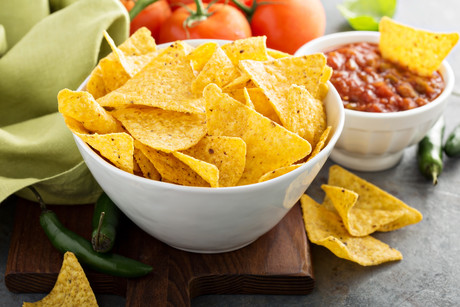Corny but true

Corn-based snacks foods like tortilla chips are a global multibillion-dollar industry, and demand for these products has seen a recent surge in popularity in Australia.
Mexican restaurants like Guzman Gomez and Taco Bell are expanding their operations as consumers are becoming more health conscious and looking to reduce their consumption of sugary-based snacks and often they are replacing these with savoury snacks.
What is the difference between a tortilla chip and a corn chip?
The process for manufacturing corn and tortilla chips is similar, but simmering and soaking times will vary considerably. Another difference is that tortilla chips are baked in the oven and then fried, while corn chips only go through the frying process.
How are corn-based snack products made?
Today, there are simple manually operated lines, semiautomatic or fully automated systems available for corn-based snack products. Corn preparation can be quite complex if you do not have the correct equipment, and the processes and equipment needed depend on which of the large variety of corn-based products you want to make.
Corn cooking preparation
The first step is to produce a dough, or masa. When cooking the corn, it is important to hydrate the corn kernels and loosen the pericarp (external skin) and to increase the moisture content of the corn by adding water. Calcium hydroxide, or ‘food grade lime’ as it can sometimes be referred to, must also be added to the corn to improve the flavour, as well as weakening and removing the outer layer of the corn pericarp so the chip is crispier. The addition of lime also controls the microbial activity, improving shelf life.
Processing systems including masa production systems and corn washers enable food manufacturers to duplicate the masa recipe every time. Extruders and sheeters are used to accurately form and transfer masa without altering the texture and flavour of the product.
Corn ovens and frying
When toasting tortilla chips, a belt moves chips through the oven and exposes both sides of the chip to the oven burners. The oven burners crust both sides of the chip and toast the bottom side of the chip using burners located under the top belt. This seals the chip and prevents the chips sticking to the belt after the first transfer point. The quantity of toast marks varies depending on what the market desires.
In the frying process, moisture is removed from the chip and replaced with oil to develop the texture, flavour and appearance of the chip. Cooking systems, such as fryers and ovens, should evenly distribute heat and give precise control of cook time and temperature.
Frying systems should provide precise control of oil flow, temperature and cook time for corn chips, tortilla chips and tostadas. A specialised range of frying systems for taco shells and tostadas is also available.
Seasoning and conveying
Conveying corn-based snack foods is a delicate process, as the product can break and the all-important seasoning can fall off if lower quality conveyor belts are used.
Help is available
Corn snack foods are an ever-changing industry, as consumers are exposed to new products and flavours. Heat and Control has long provided the equipment and means for snack food producers to keep up with demand of this burgeoning market by providing complete system equipment lines, from masa production to forming, toasting, conditioning, frying, seasoning and inspection for tortilla and corn chips, taco shells, tostadas, corn tortillas, extruded corn snacks and fried corn kernels.
The company’s complete Corn Product Systems are designed by engineers with years of experience in snack food products, and the company is a single source supplier of all the equipment needed to process, season, weigh, inspect and package the highest quality tortilla chips, corn chips and other corn snacks.
For example, the FastBack Horizontal motion conveyor can reduce product breakage by up to 60% while the gentle slow-forward, fast-back motion prevents product damage and seasoning coating loss. The Heat and Control seasoning applicators, such as the FastBack Revolution Seasoning Systems, uniformly apply seasonings with less breakage and waste.
Six beverage trends predicted for 2026
Demand for customisation, 'protein-ification' and sustainable storytelling are some of...
Making UHT processing less intensive on energy
A nutritional beverages company was seeking a more sustainable way to produce UHT beverages using...
Tasty twist for chocolate alternatives
Food scientists develop two novel flavour-boosting techniques to transform carob pulp into a...











